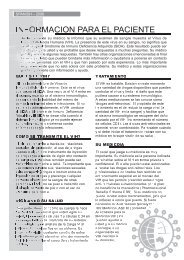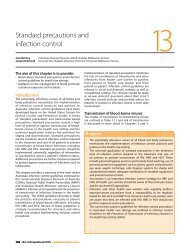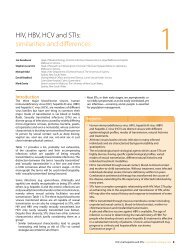B Positive – all you wanted to know about - ASHM
B Positive – all you wanted to know about - ASHM
B Positive – all you wanted to know about - ASHM
Create successful ePaper yourself
Turn your PDF publications into a flip-book with our unique Google optimized e-Paper software.
irrespective of language difficulties, patients<br />
should understand the aims of treatment,<br />
namely:<br />
� <strong>to</strong> achieve prolonged suppression of HbV<br />
replication and<br />
� <strong>to</strong> arrest (or reverse) the progression of liver<br />
damage, with the ultimate goal of preventing<br />
cirrhosis, Hcc and liver failure.<br />
it is important that patients have an<br />
understanding of the key fac<strong>to</strong>rs, including<br />
the role of liver biopsy, which influence the<br />
decision <strong>to</strong> commence treatment.<br />
Pegylated interferon, lamivudine and entecavir<br />
are approved for reimbursement by the<br />
Pharmaceutical benefits advisory committee<br />
(Pbac) for initial antiviral treatment in patients<br />
with cHb. Patients should be advised that the<br />
selection of the most appropriate antiviral<br />
therapy depends on many fac<strong>to</strong>rs, including<br />
safety, efficacy and cost. Pegylated interferons<br />
are administered for a defined duration—but<br />
patients require pre-treatment education and<br />
ongoing support while on therapy, due <strong>to</strong> the<br />
adverse events associated with their use.<br />
nucleoside analogues (na), e.g. lamivudine<br />
and entecavir, are gener<strong>all</strong>y very well <strong>to</strong>lerated,<br />
with a limited number of side effects. a<br />
major concern with their long-term use is the<br />
emergence of antiviral resistant mutations.<br />
the emergence of antiviral resistant mutants<br />
is related <strong>to</strong> previous exposure <strong>to</strong> nas, the<br />
duration of therapy, the pre-treatment HbV<br />
dna level and the rate of decline of HbV dna<br />
levels after therapy has commenced. adefovir,<br />
while effective in suppressing wild type and<br />
lamivudine-resistant HbV, is only available<br />
under the Pharmaceutical benefits scheme<br />
(Pbs) in australia for the treatment of resistant<br />
HbV. entecavir is also available for the treatment<br />
of lamivudine-resistant HbV, but a higher dose<br />
(1.0 mg) is recommended than for treatmentnaïve<br />
patients (0.5 mg). 5<br />
Hbeag-positive patients are treated until they<br />
establish Hbeag seroconversion and maintain<br />
the immune control phase (Hbeag negative,<br />
Hbsag positive and low HbV dna). Hbeagnegative<br />
patients often need <strong>to</strong> be treated<br />
indefinitely, as relapse is common. for this<br />
reason, the decision <strong>to</strong> use nas needs <strong>to</strong> be<br />
considered carefully because of the risk of viral<br />
resistance. treatment is often deferred until<br />
later for patients in their twenties or <strong>you</strong>nger,<br />
unless there are indica<strong>to</strong>rs of significant liver<br />
disease or a family his<strong>to</strong>ry of Hcc. 2<br />
combination antiviral therapy has proved <strong>to</strong><br />
be highly beneficial in preventing antiviral<br />
resistance in HiV and it is likely that a similar<br />
scenario will emerge in HbV treatment (see<br />
chapter 2: Virology: viral replication and drug<br />
resistance).<br />
Patients interested in starting a family<br />
should consider the safety profile of various<br />
treatment options and the restricted access <strong>to</strong><br />
treatment under Pbs section100 criteria. the<br />
management decision for patients initiated on<br />
treatment who later become pregnant must be<br />
individualised. there are abundant safety data<br />
for lamivudine in HiV-treated patients that may<br />
facilitate a discussion on the risks and benefits<br />
of treatment cessation, including a potential<br />
flare of disease activity during pregnancy.<br />
initiating a patient prior <strong>to</strong> family planning with<br />
pegylated interferon may be an alternative<br />
option, as interferon treatment is limited <strong>to</strong> a<br />
defined duration.<br />
treatment of chronic hepatitis b is discussed in<br />
more detail in chapter 7: treatment of chronic<br />
hepatitis b virus infection.<br />
Screening for hepa<strong>to</strong>cellular<br />
carcinoma<br />
an important element in the assessment<br />
of a patient with cHb is the issue of Hcc<br />
screening. Hcc screening is recommended for<br />
patients with cHb at high risks for Hcc (table<br />
6.3). screening is recommended every six<br />
months using ultrasound or a combination of<br />
ultrasound and alpha fe<strong>to</strong>protein estimation. 2<br />
b <strong>Positive</strong> <strong>–</strong> <strong>all</strong> <strong>you</strong> <strong>wanted</strong> <strong>to</strong> <strong>know</strong> <strong>about</strong> hepatitis b: a guide for primary care providers 55






